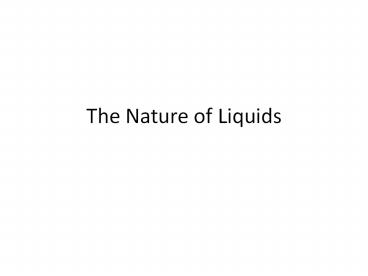The Nature of Liquids PowerPoint PPT Presentation
Title: The Nature of Liquids
1
The Nature of Liquids
2
A Model for Liquids
- According to the kinetic theory, both the
particles that make up gases and liquids have
motion. - While particles in gases are not attracted to
each other, particles in liquids are.
3
A Model for Liquids
- The attractive forces between molecules are
called intermolecular forces. - The forces allow the particles in liquids to
slide past one another.
4
A Model for Liquids
- Most of the particles of liquids do not have
enough kinetic energy to overcome the
intermolecular forces and escape into the gaseous
state. - Liquids take the shape of its container.
5
A Model for Liquids
- The interplay between the disruptive motions of
particles of a liquid and the attractive forces
between them causes liquids to flow and have
definite volumes.
6
A Model for Liquids
- Intermolecular forces also reduce the amount of
space between the particles in a liquid, which
makes them more dense than gases. - Increasing the pressure on a liquid has hardly
any effect on its volume. So, liquids and solids
are known as condensed states of matter.
7
Evaporation
- The conversion of a liquid to a gas or vapor is
called vaporization. - When it goes from a liquid to a gas at the
surface of a liquid that is not boiling, the
process is called evaporation.
8
Evaporation vs. Boiling
9
Evaporation
- In evaporation some molecules in the liquid break
away and enter the gas or vapor state. Only those
molecules of the liquid with a certain minimum
kinetic energy can break away from the surface.
10
Evaporation
- Added heat increases the average kinetic energy
of the liquids particles. - The energy enables more particles to overcome the
attractive forces keeping them in the liquid
state. - As evaporation occurs, the particles with the
highest kinetic energy tend to escape first.
11
Vapor Pressure
- When a partially filled container of liquid is
sealed, some of the particles in the liquid
vaporize. - These particles collide with the walls of the
sealed container and produce a vapor pressure, or
a force due to the gas above the liquid.
12
Vapor Pressure
- As time passes, the number of particles entering
the vapor increases and eventually some particles
will return to the liquid, or condense. - After a time, the number of vapor particles
condensing will equal the number of liquid
particles vaporizing and the vapor pressure will
remain constant.
13
Vapor Pressure
- In a system at constant vapor pressure, a dynamic
equilibrium exists between the gas and the
liquid. Within the system, the rate of
evaporation of liquid equals the rate of
condensation of vapor.
14
Vapor Pressure and Temperature Change
- An increase in the temperature of a contained
liquid increases the vapor pressure. - The vapor pressure of a liquid can be determined
by means of a device called a manometer.
15
Vapor Pressure Measurements
- In a simple manometer, one end of a U-shaped
glass tube containing mercury is attached to a
container. The other end of the tube is open to
the surrounding atmosphere.
16
Vapor Pressure Measurements
- When a liquid is added to the container, the
pressure in the container increases due to the
vapor pressure of the liquid. - The vapor pressure of the liquid pushes the
mercury on the container side of the U-tube the
levels of mercury in the U-tube are no longer the
same.
17
Boiling Point
- When the liquid is heated to a high enough
temperature, many of the particles throughout the
liquid have enough kinetic energy to vaporize. At
that point, boiling (or vaporization throughout
the liquid) occurs.
18
Boiling Point
- The boiling point (bp) is the temperature at
which the vapor pressure of the liquid is just
equal to the external pressure. - Bubbles of vapor form throughout the liquid, rise
to the surface, and escape into the air as the
liquid boils.
19
Boiling Point and Pressure Changes
- The boiling point of a liquid varies with the
external pressure. - At high altitudes, the atmospheric pressure is
lower than it is at sea level which allows the
liquid to boil at a lower temperature.
20
Boiling due to Altitude
21
Boiling Point and Pressure Changes
- Boiling point decreases at lower pressure and
increases at higher pressure. - At lower pressure, the boiling point decreases
because the particles need less kinetic energy to
escape the liquids. - At higher external pressures, a liquids boiling
point increases because the particles in the
liquid need more kinetic energy to escape.
22
Boiling Point and Pressure Changes
- The temperature of the boiling liquid never rises
above its boiling point. - If heat is supplied at a greater rate, the liquid
only boils faster. - The vapor produced is at the same temperature as
that of the boiling liquid.
23
Normal Boiling Point
- Because a liquid can have various boiling points
depending on pressure, the normal boiling point
is defined as the boiling point of a liquid at a
pressure of 101.3 kPa.

